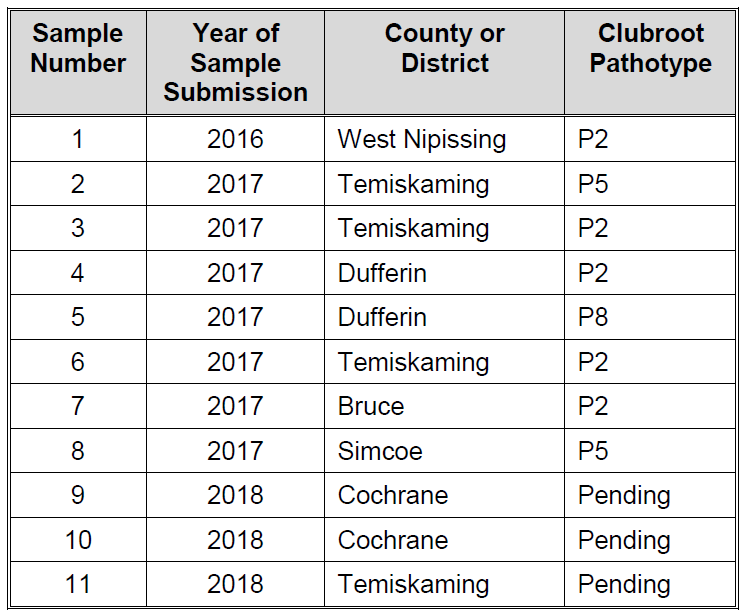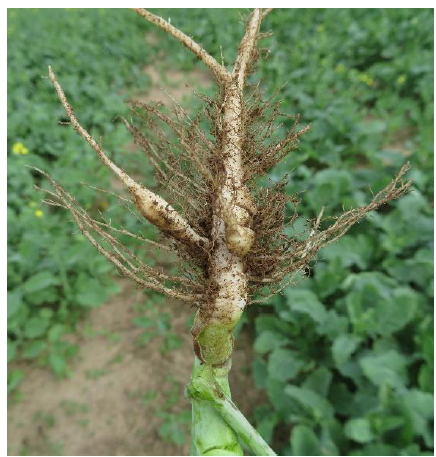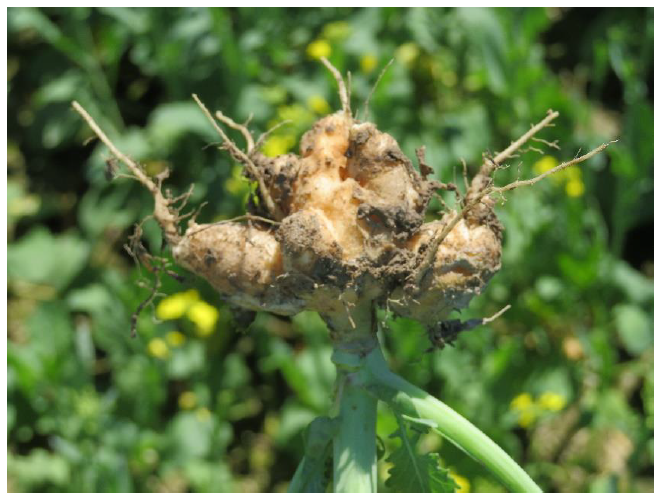Purpose
Clubroot disease has been found in approximately 20 canola fields across Ontario over the past 3 years, affecting at least 14 individual farmers/farm operations. It is present in nearly all Ontario canola growing regions, including the following counties and districts: Algoma, Cochrane, Temiskaming, West Nipissing, Bruce, Grey, Dufferin and Simcoe. Clubroot has also been reported in other regions of Ontario that produce brassica vegetables (e.g. broccoli, cauliflower) since as far back as the 1960’s.
A pathotype is defined as a group of organisms within a species that have the same pathogenicity, or ability to cause disease, on a specific host. For example, some clubroot pathotypes appear to cause more damage to brassica vegetables than they do to canola. There may also be differences in the ability of a pathotype to infect different canola varieties. The various clubroot pathotypes are each assigned a number, e.g. P2.
The purpose of this research is to determine the clubroot pathotypes present in Ontario canola fields. Clubroot cannot be eradicated from an infected field, but the pathotype present in a given field may shift over time. Pathotype identification is important because the clubroot resistance trait present in a given canola variety must match the pathotype found in the field in order for the variety to perform adequately.
Methods
Infected canola plants showing clubbed root symptoms were collected from farm fields and delivered to the lab of Dr. Mary Ruth McDonald at the University of Guelph. As the root tissue begins to rot, researchers are able to collect clubroot spores. The spores are used to infect a group of host plants that serve to distinguish between the pathotypes based on disease symptoms; these host plants are called a “differential set”. Based on the disease symptoms observed in the “differential set”, trained researchers identify and report the predominant clubroot pathotype found in the sample.
If canola plants with clubbed roots are not available, but a soil is known to be infected with the disease, a bucket of soil is collected and used to produce infected plants in containers in a growth room. Again, spores are collected from the clubbed root tissue produced from the farm soils and are used on the “differential set” to determine the clubroot pathotype.
Results
It can take many weeks to determine the clubroot pathotype present in a farm field. To date, 8 samples have been assessed for their pathotype, and 3 are currently being processed. Additional soil or plant samples will be collected from infected fields in the 2019 season.
To date, three different clubroot pathotypes have been identified in Ontario canola fields. There are multiple pathotypes in each canola growing region; the pathotypes do not appear to be specific to certain regions. Five samples have been identified as P2, two samples were P5, and one sample was P8.
Pathotype analysis has also been conducted on brassica vegetable samples with clubroot infection. The vegetable production fields were located primarily in Oxford and Norfolk counties, and were identified as P6 and P5.
Western Canada have primarily dealt with P3 and P5, although there have now been over a dozen pathotypes identified in the west. Continued use of clubroot resistant canola varieties under short crop rotations in fields with very high levels of clubroot spores creates a selection pressure leading to shifts in the pathotype populations. Some western Canadian canola growers now have clubroot pathotypes in their fields for which there are no clubroot resistant canola varieties.
Table 1. Clubroot Pathotype Identified in Infected Ontario Canola Fields from 2016 to 2018.

Summary
Clubroot disease is a significant threat to canola production in Ontario and across Canada. Above ground symptoms of clubroot include yellowing, stunting, wilting, premature ripening, and premature plant death. Proper diagnosis of clubroot infection must include digging up plant roots to check for gall formation. Roots of infected plants become malformed and cannot adequately transport water or nutrients.
Clubroot spores can remain dormant in soil for 20 years or more, and cannot be eradicated from fields. There may be little to no yield loss in fields where clubroot has been detected if spore counts in the field remain low. Yield losses can be up to 100% when spore counts are high, soil pH is below 6.5, and when soils are wet. There are currently no pesticides that offer effective control.
Ontario canola growers are encouraged to begin using clubroot resistant canola varieties before they have high levels of clubroot spores in their fields. It is advisable to begin growing resistant varieties even before clubroot is detected on your farm, particularly if there is a risk of infection because you farm in a region where clubroot has been found and/or you use custom services such as scouting, spraying, harvesting, or renting shared equipment such as fertilizer spreaders. Any way that soil can move from one field to another is also an avenue for clubroot movement.
Growing a resistant variety before clubroot is detected can significantly mitigate the spread of the disease, and will protect yield and the long term profitability of canola. It is difficult to find clubroot in the first year it appears on your farm, because there will be low levels of infection and only a few infected plants. However, just a few infected plants can quickly lead to high spore counts because each infected plant contributes billions of new spores back to the soil. Those spores are spread around the field by tillage and other field activities, and can be moved to other fields on equipment. Growing a susceptible canola variety for just 2 years too long can lead to significant yield loss and high levels of infection.
If a few pounds of clubroot infected soil is transferred to your farm, but you are prepared in advance and are already growing a clubroot resistant variety, those clubroot spores will not be able to reproduce and proliferate in your soils. Fewer spores in a field reduces the chance of resistance breaking down, as has occurred in fields in Western Canada. Keeping spore counts low improves our ability to successfully grow canola into the future, mitigates the spread of the disease from farm to farm, and protects the longevity of clubroot resistant varieties.
If you start growing resistant varieties after you have seen significant clubroot damage in your field, there will already be a high level of spores present and there may be more than one pathotype present. Resistant varieties are not always perfect, as they can show symptoms if spore counts are very high so it is best to deploy them early. Planting a resistant variety on a field that has a high clubroot spore count creates a selection pressure, allowing reproduction of those spores that are not targeted by the resistant variety. This can lead to a shift towards pathotypes we cannot target with currently available resistant varieties.
There are multiple clubroot pathotypes present on Ontario farms, including P2, P5 and P8 in canola fields, as well as P5 and P6 in brassica vegetable fields. Ontario canola or brassica vegetable growers looking to confirm whether clubroot is present on their farm fields are encouraged to contact Meghan Moran or Travis Cranmer of OMAFRA. A soil sample will be submitted for a “yes/no” confirmation of the presence of clubroot in the soil. If clubroot is detected, pathotype analysis can be conducted with support from the University of Guelph.
Ontario canola growers are encouraged to speak with their seed dealers about the resistance traits offered in canola varieties to ensure they are growing resistant varieties that match the pathotypes found on their farm or in their region. Most clubroot resistant varieties cover a range of pathotypes. If clubroot has not yet been detected on your farm, choose a variety that is resistant to P2, P5 and P8.
More information about clubroot management in canola can be found at
www.clubroot.ca and www.FieldCropNews.com
Figure 1. Example of Low Levels of Clubroot Symptoms on a Canola Plant. This Plant Still Has Roots and Root Hair to Take Up Water And Nutrients.

Figure 2. Example of Extreme Clubroot Symptoms. This Plant has few Roots and Root Hairs to Take Up Nutrients. The Above Ground Plan Parts Were Wilted and Stunted. This Plant Will Die Before it Sets Seed.

Acknowledgements
The canola clubroot survey was led by Meghan Moran (OMAFRA Canola and Edible Bean Specialist), and the vegetable clubroot survey was conducted by Travis Cranmer (OMAFRA Vegetable Crops Specialist). Clubroot pathotype analysis is conducted by Dr. Fadi Al-Daoud and Dr. Mary Ruth McDonald, at the University of Guelph. Daniel Tassé and Pierrette Desrocher, OMAFRA Agriculture Development Advisors from New Liskeard and Verner, respectively, provided a great deal of assistance in contacting farmers, collecting samples and communicating results. There were over 60 farmer participants in the survey, as well as 10 agronomists. OMAFRA would like to thank them for their cooperation.
This project is funded by the OMAFRA/UG Partnership.
Project Contacts
Meghan Moran
Canola and Edible Bean Specialist, OMAFRA
meghan.moran@ontario.ca
519-546-1725
Travis Cranmer
Vegetable Crops Specialist, OMAFRA
travis.cranmer@ontario.ca
519-835-3382
